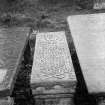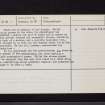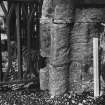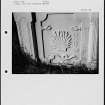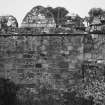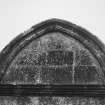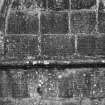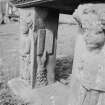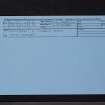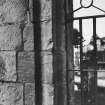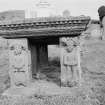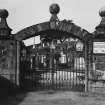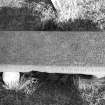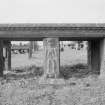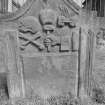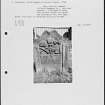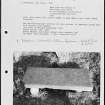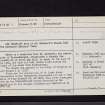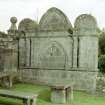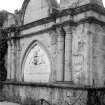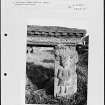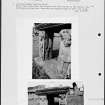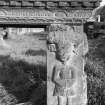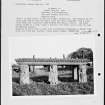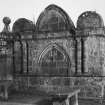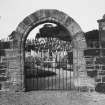Kirkcudbright, St Cuthbert's Church And Graveyard
Burial Ground (Early Medieval), Cemetery (Post Medieval), Church (Early Medieval)
Site Name Kirkcudbright, St Cuthbert's Church And Graveyard
Classification Burial Ground (Early Medieval), Cemetery (Post Medieval), Church (Early Medieval)
Alternative Name(s) Kirkcudbright, Old Kirkyard And Martyrs' Tomb; Kirkcudbright, St Cuthbert's Road, Cemetery
Canmore ID 64069
Site Number NX65SE 30
NGR NX 69073 51128
Datum OSGB36 - NGR
Permalink http://canmore.org.uk/site/64069
- Council Dumfries And Galloway
- Parish Kirkcudbright
- Former Region Dumfries And Galloway
- Former District Stewartry
- Former County Kirkcudbrightshire
NX65SE 30 6903 5119
See also NX65SE 34.
(NX 6903 5119) Site of St Cuthbert's Church (NR)
(8th Century): Martyrs' Tomb.
OS 6" map (1954)
There is a tradition that St Cuthbert, the patron saint of Kirkcudbright, established a church, the foundations of which may still be seen, to the east of the town, and that his body rested there during the flight of the monks from Lindisfarne. The church was granted to the Abbey of Holyrood by Lord Fergus (d.1161).
There are the gravestones of at least three Covenanters in St Cuthbert's Churchyard (J H Maxwell 1912) and a lead bulla of Pope Clement II, AD 1047, also found there was lent by the Kirkcudbright Museum Association for exhibition at the Glasgow International Exhibition in 1888.
J Robison 1927;
There are no remains of the church. Whilst digging graves at the site, the gravedigger has unearthed (during the past 30 years and as recent as 1953) several dressed and ornamental stones, including the arch of a window, and a possible baptismal font, all thought to be from the old church; these lie in the grave-yard. He has not, however, encountered any foundations.
In the grave-yard are two grave-stones, one covering the graves of two covenanters, the other marking a single covenanter's grave. Whilst the stones appear to be original they may have been recut at a later date, the inscriptions being perfectly legible; the inscriptions appear to be 18th C work.
Visited by OS (EGC) 5 February 1965
NX65SE 30 69073 51128
Photographic Record (1985)
Recording of gravestones in the churchyard of St Cuthbert's Church, Kirkcudbright, by Mrs Betty Willsher c1985.
Photogrammetric Survey (4 October 2014 - 5 October 2014)
NX 69073 51128 The ACCORD (Archaeology Community Co-production Of Research Data) Project was an Arts and Humanities Research Council (AHRC) funded research project led by the Digital Design Studio (Glasgow School of Art), with the University of Manchester, RCAHMS and Archaeology Scotland, which worked with 10 community groups across Scotland from October 2013 to March 2015. The project aimed to co-design and co-produce 3D digital data of heritage sites that are of significance to the community groups and which they wished to record.
The ACCORD team worked with the Kirkcudbright History Society, from the 4–5 October 2014. Together, working in the Kirkcudbright Kirkyard, we modelled three grave monuments using photogrammetry (two are archived with the ADS) and recorded the inscriptions on two of these using the technique of Reflectance Transformation Imaging (RTI). The three grave monuments included one dedicated to the traveller Billy Marshall who died in 1792, an 18th-century gravestone with one face completely occupied by raised lettering, and an ornate tablestone grave dedicated to Samuel Herries who died in 1793.
Archive: ADS and National Record of the Historic Environment (NRHE)
Funder: Arts and Humanities Research Council
Stuart Jeffrey and Mhairi Maxwell – Glasgow School of Art
(Source: DES, Volume 16)
Artefact Recovery (July 2021)
NX 69080 51120 During the course of the excavation of a new grave in the cemetery, in July 2021, a ring-pin of Hiberno-Norse type, was found. It is generally similar in form and size to one found with the Viking sword discovered elsewhere in the cemetery in 1887. As well as the pin, a circular lead object was found in the same excavation. The finder and one of the contributors (DD) checked the remaining spoil from the grave for further artefacts, but no other material of medieval or earlier date was found.
Other finds included early 18th-century slipware and late 19th-century blue transfer wares. It is understood that prior to its current use for burials, this part of the cemetery had been levelled. Consequently, the two finds may have been disturbed from their original deposition locations and re-deposited at the findspot. The discovery of a second ring-pin in the cemetery may imply a second Norse burial in the area to the E of the site of the Anglian minster church, which is understood to be located in the oldest part of the cemetery. Whereas the ring-pin is a relatively common and recognisable type of Hiberno-Norse artefact, often associated with burials, the identification of the lead object is not immediately clear, but its use as a weight is perhaps one possibility. The artefacts are currently in the possession of the Stewartry Museum, Kirkcudbright pending delivery to the Treasure Trove Unit in Edinburgh, but it is expected that they will find their permanent home in the Stewartry.
Archive: Stewartry Museum
David Devereux and Peter Hewitt
(Source: DES Vol 22)


































